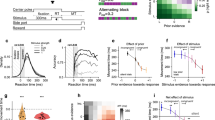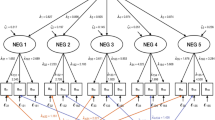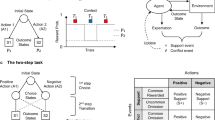Abstract
EXPERIMENTS on shape discrimination in rats, using the Lashley two-card jumping stand, have shown that, when rats are pre-trained to discriminate horizontal from vertical striations (horizontal positive), they tend to choose other shapes with a horizontal base-line, such as a square, triangle or pentagon, in preference to a second shape which lacks the horizontal base, such as a circle or inverted triangle. This suggests that a horizontal line in one shape of a pair which have to be discriminated from one another is isolated by the animal as a basis for discrimination; this has been verified for a number of ‘transfer’ shapes, and in each case the horizontal base was the effective element in discrimination. These experiments, reported in detail elsewhere1, were designed to overcome objections to earlier work in this field, for example, the classic studies of Lashley2.
This is a preview of subscription content, access via your institution
Access options
Subscribe to this journal
Receive 51 print issues and online access
$199.00 per year
only $3.90 per issue
Buy this article
- Purchase on SpringerLink
- Instant access to full article PDF
Prices may be subject to local taxes which are calculated during checkout
Similar content being viewed by others
References
Dodwell, P. C., Brit. J. Psychol. (in the press).
Lashley, K. S., J. Gen. Psychol., 18, 123 (1938).
Sutherland, N. S., Nature, 179, 11 (1957).
Author information
Authors and Affiliations
Rights and permissions
About this article
Cite this article
DODWELL, P. Shape Discrimination in the Octopus and the Rat. Nature 179, 1088 (1957). https://doi.org/10.1038/1791088a0
Issue date:
DOI: https://doi.org/10.1038/1791088a0
This article is cited by
-
The Cartesian frame of reference: A structure unifying the description of dyslexia
Journal of Psycholinguistic Research (1974)
-
Facts and Theories of Shape Discrimination
Nature (1961)
-
The Plexiform Zone and Shape Recognition in the Octopus
Nature (1960)
-
Shape Discrimination in the Octopus
Nature (1957)



